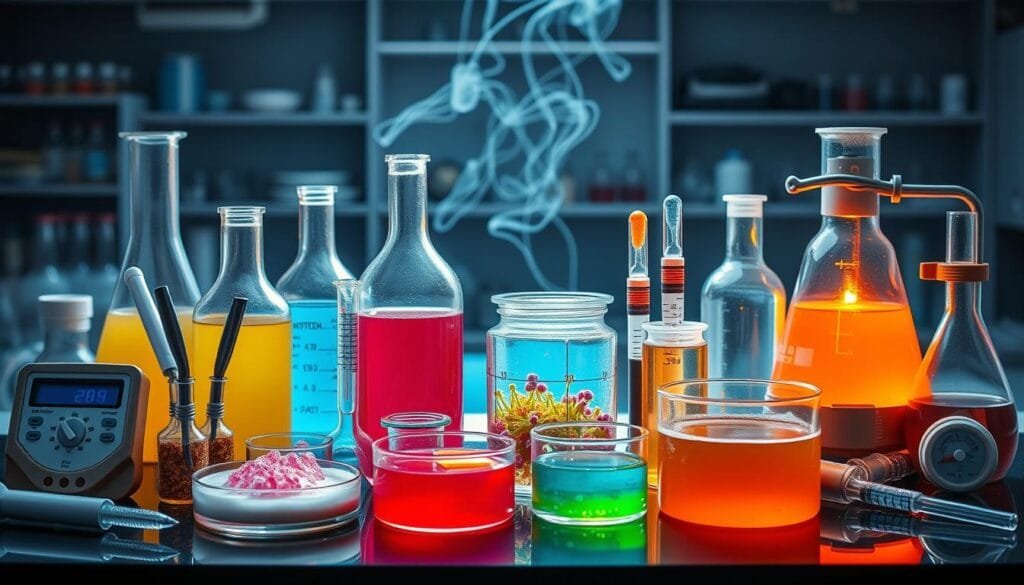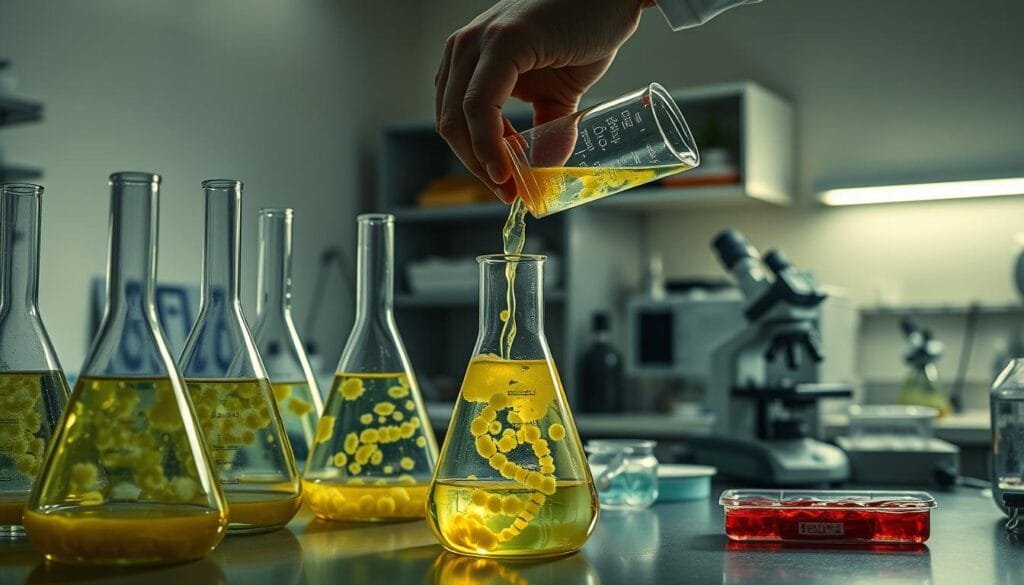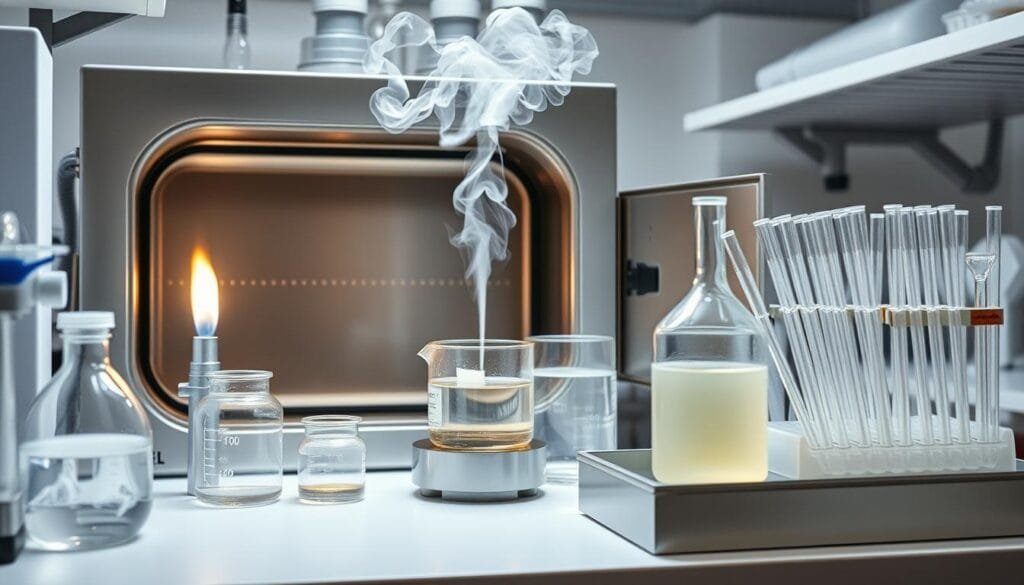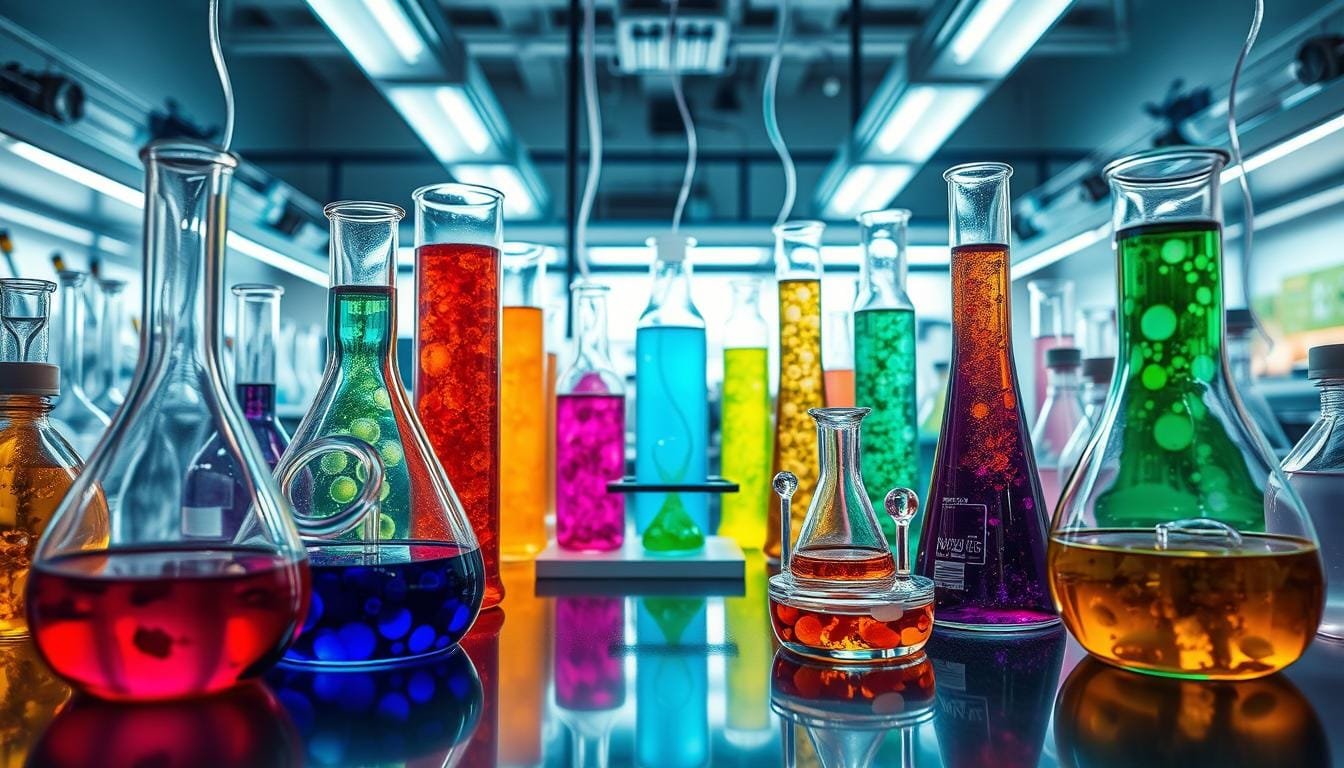Imagine a method that boosts mushroom growth, quicker and cheaper than old ways. Liquid culture microbiology changes how we grow mushrooms and prepare grain spawn. Using a special solution, mushroom mycelium grows faster and more reliably. This means less need for pricey lab gear. Want to know how this can make growing easier for you?
Key Takeaways
- Liquid culture is more predictable and faster than traditional spore inoculation.
- This method simplifies grain spawn preparation.
- Liquid culture reduces the need for costly laboratory equipment.
- Nutrient-rich solutions help in faster mycelium growth.
- Proper sterile techniques greatly reduce the risk of contamination.
Understanding Liquid Culture in Microbiology
Liquid culture basics show us it’s a blend of mushroom mycelium and nutrient-rich liquid. This method is mainly for inoculating grain to grow mushrooms. It’s like using seeds in gardening but in a controlled setup.
What is Liquid Culture?
Liquid culture is a medium for growing mushrooms in sterilized liquid. Louis Pasteur developed it in 1860. It’s crucial in microbiology for fast microorganism growth. Ingredients are simple, like water and honey. It’s designed to be free from contamination, making it great for large-scale use. For more history and techniques, see more here.
Benefits of Liquid Culture Over Traditional Methods
Here are the key advantages of liquid culture:
- Ease of Use: It makes growing microorganisms simple, even at home.
- Rapid Colonization: Cultures grow fast, cutting down cultivation time.
- Lower Contamination Risk: The sterile environment lowers contamination chances.
- Cost-Effective: It uses simple ingredients, keeping costs down.
- Efficient Production: It’s helpful for both new and experienced growers.
Liquid culture is a big improvement over past methods. For example, Robert Koch’s solid media in 1881 and Julius Petri’s innovations in 1887. It has increased the efficiency and diversity of microbial growth since not all bacteria can be isolated on selective media.
To sum up, liquid culture has many benefits over old techniques. These include being user-friendly, quick colonization, low contamination risk, and being cost-effective. As we study more, we see how vital it is to modern microbiology.
For a deep dive into these methods and their history, check out the detailed research here.
Essential Ingredients and Equipment
To dive into microbiology, you need the right stuff. This ensures success in making liquid cultures. Whether you’re a newbie or somewhat experienced, knowing what you need is key. It makes the process smoother and the results better. Here, we’ll cover the must-have ingredients and gear for top-notch liquid culture.
Key Ingredients for Liquid Culture
Ingredients for liquid culture are crucial for growth. You’ll need sugars like light malt extract, dextrose, and honey. These feed the mycelium. Also, adding 2.5 grams of FeSO4·7H2O per liter helps with iron. These components create a good home for the microbes.
Necessary Equipment
Having the right tools is just as important as the ingredients. Here’s what you essential for liquid culture:
- Digital Gram Scales: They help you measure ingredients precisely.
- Distilled Water: This keeps your culture pure and consistent.
- Canning Jars with Airport Lids: They allow some cultures to breathe.
- Pressure Cookers: You use these to sterilize the medium at 121°C for 15 minutes at over 15 psi.
Optional Equipment for Enhanced Results
While the basics are enough, some extra tools can make your liquid culture even better. Here are a few:
- Magnetic Stir Bars and Stirrers: These are for easy mixing. But shaking by hand works too.
- Autoclave: Perfect for complete sterility, reaching 121°C at 15 psi for 15 minutes. This kills most microbes.
- Filter-sterilizers: Great for solutions that heat can damage, like those with a lot of protein.

| Required Equipment | Function |
|---|---|
| Digital Gram Scale | Precision measurement of ingredients |
| Distilled Water | Ensures consistency in homemade liquid culture |
| Canning Jars with Airport Lids | Maintains necessary aerobic conditions |
| Pressure Cooker | Sterilizes media at 121°C for 15 minutes under 15 psi pressure |
| Optional Equipment | Function |
| Magnetic Stir Bars and Stirrers | Automatic mixing of cultures |
| Autoclave | Maintains sterility with high-temperature and pressure |
| Filter-Sterilizers | Sterilizes heat-sensitive solutions |
How to Start a Liquid Culture Microbiology
Starting liquid culture is both careful and rewarding, key to microbiology. It involves measuring and mixing ingredients under clean conditions. This stops contaminants. Here, we’ll go over what you need for a good start.
Starting with mushroom culture requires precise prep. First, make a sugar solution with the right amount of water and sugar. This is your culture’s base.
Accurate mixing is critical to avoid contamination, which could ruin the culture.
Then, put the sugar solution in a clean container. It’s vital to sterilize the container well to avoid any germs. Use lids that let air in but keep germs out.
It’s also important to track how long cultures last. For example, bacterial cultures last about 4 to 6 weeks on agar plates at 4°C. In a freezer at -20°C, they can last 1 to 3 years. For very long storage, options like freeze-drying can extend their life from 1 to 10 years. Add DMSO and glycerol at 5–15% to help them recover after freezing.
- Make a sugar solution by mixing sugar in water.
- Clean the container and lid well to avoid germs.
- Put the solution in the clean container and attach the lid.
Beginning liquid culture needs the right conditions and careful steps. By using these tips, the culture stays healthy and contamination is avoided. Following these steps carefully is key to growing a successful culture.
| Storage Temperature | Viability Period |
|---|---|
| 4°C (Agar Plates) | 4 – 6 weeks |
| 4°C (Stab Cultures) | 3 weeks – 1 year |
| -20°C (Freezer) | 1 – 3 years |
| -80°C (Super-cooled Freezer) | 1 – 10 years |
| ≤4°C (Freeze-dried) | 15 years or more |

Steps to Prepare Liquid Culture
Making liquid culture is key for growing mushrooms well. To start, follow detailed steps to keep things clean and perfect for mycelium growth. We’ll look at the important parts from beginning to the end of making liquid culture.
Preparing the Liquid Culture Solution
We begin by mixing sugar with distilled water. This mix goes into a clean jar with either a magnetic stir bar or a glass marble. It’s the first step to create a nutrient-full home for the mycelium. Being careful in this step ensures reliable outcomes.
Also, keeping the right temperature for incubation is crucial for mycelium to grow successfully.
Filtering and Sealing the Jar
Once the solution is ready, filtering it removes unwanted particles. Then, sealing the jar with an airport lid allows air in but keeps germs out. This action is vital to keeping the space free from contamination, which is a common issue in mycology.
Sterilization Process

To sterilize the liquid culture, we use a pressure cooker or an autoclave. These devices use steam under pressure to kill all contaminants. Staying clean during this step helps prevent adding any bad microorganisms. The usual sterilizing conditions include high pressure and temperature for a certain time to destroy bacteria and fungi.
Inoculation and Agitation
After sterilizing, the culture is ready for inoculation. We add mushroom spores or mycelium to the clean solution. Usually, we use 1-2 ml of liquid culture with a 10 ml syringe. Then, we need to stir the jar to spread the nutrients and keep the mycelium mixed in the solution. This can be done with a magnetic stirrer or by shaking the jar by hand.
In the end, following each step carefully when making liquid culture helps mycelium grow well. This careful process boosts success rates and reduces contamination, leading to a strong and healthy mycelium culture.
Monitoring and Identifying Contamination
Keeping an eye on liquid culture is key to avoid big problems from contamination. It’s important to always check for signs that show if a culture is healthy or not. This includes looking at signs of good liquid culture and symptoms of contamination.
Healthy vs. Contaminated Liquid Culture
To keep a liquid culture healthy, watch for clear signs of growth. A healthy culture has clear liquid and visible mycelium. But if you see cloudiness, weird smells, or color changes, the culture might be contaminated. This can ruin the culture’s quality and usefulness.
Signs of Contamination
Spotting contamination early can save a lot of trouble. Knowing what a healthy culture looks like compared to a sick one is very helpful. Below is a quick guide:
| Characteristic | Healthy Liquid Culture | Contaminated Liquid Culture |
|---|---|---|
| Appearance | Clear solution | Cloudy or murky |
| Smell | Neutral or slightly earthy | Foul or unusual odor |
| Color | Uniform | Discolored or spotted |
| Growth | Visible mycelium | Irregular or abnormal formations |
It’s critical to monitor and test cultures regularly. This helps keep the experiments accurate and reproducible. By doing so, you can fight liquid culture contamination. Contamination can especially affect the growth features of special serums used in cultures.
Interestingly, almost all cell culture labs face contamination at some point. This is why being good at spotting contamination is key for success in these labs.
Conclusion
We explored the key steps and safety measures needed for effective liquid culture in microbiology, with a focus on mushrooms. We started by explaining what liquid culture is and why it’s better than old ways. We then looked at what you need to make your liquid culture, including the must-have tools and steps like sterilizing and inoculating.
Keeping an eye out for contamination is also crucial for a successful liquid culture. It’s important to tell healthy from unhealthy cultures to ensure strong mycelium growth. Keeping everything clean, using aseptic techniques, and sterilizing properly are key.
Finally, we urge both beginners and skilled growers to get good at these methods for better mushroom growth. By following these tips, you can improve mycelium quality and make your liquid culture projects more successful. These mushroom growing tips will boost your efficiency and help you achieve better results.
FAQ
What is liquid culture in microbiology?
Liquid culture mixes mushroom mycelium with a nutrient-rich liquid. It’s mainly used to start mushroom growing on grain. This method speeds up and makes the inoculation more reliable than using spores.
What are the benefits of liquid culture over traditional methods?
Liquid culture leads to faster mycelium growth and lower contamination risks. It’s user-friendly and cost-effective. This way, both newbies and experienced growers find mushroom farming simpler, using just water and honey.
What are the key ingredients for successful liquid culture?
The key ingredients are sugars like light malt extract, dextrose, and honey. These feed the mycelium. Also, distilled water is vital to avoid contamination and ensure healthy mycelium expansion.
What equipment do I need to start a liquid culture?
You’ll need digital scales, distilled water, canning jars with airport lids, and a pressure cooker. Additionally, magnetic stir bars and stirrers can help but are not essential. Simple shaking works fine too.
How do I start a liquid culture for mushroom cultivation?
Begin by sterilizing your solution of key ingredients in a pressure cooker. After, the solution in a jar is added to mushroom spores or mycelium. It is important to keep shaking it for a good nutrient spread.
What is the process for preparing a liquid culture?
You dissolve sugar in distilled water and put it in a sterile jar. If you have one, add a magnetic stir bar or glass marble. Seal it up with an airport lid. Then, sterilize it in a pressure cooker. After that, you add the culture and shake well.
How do I identify contamination in my liquid culture?
Keep an eye on your culture for signs of issues. A good culture looks clear with white mycelium. Signs like cloudiness, weird smells, or odd colors mean there might be contamination. Catching these early is key.
What are the signs of a healthy liquid culture?
A clear solution with white mycelium means the culture is healthy. Watch out for cloudiness or bad smells as these suggest problems.
